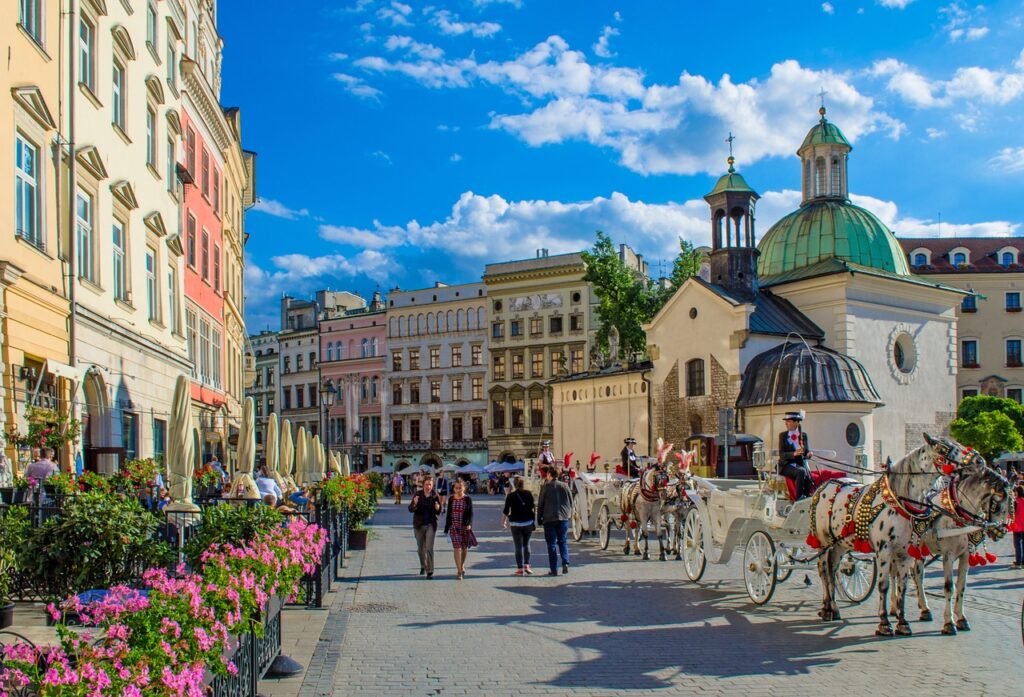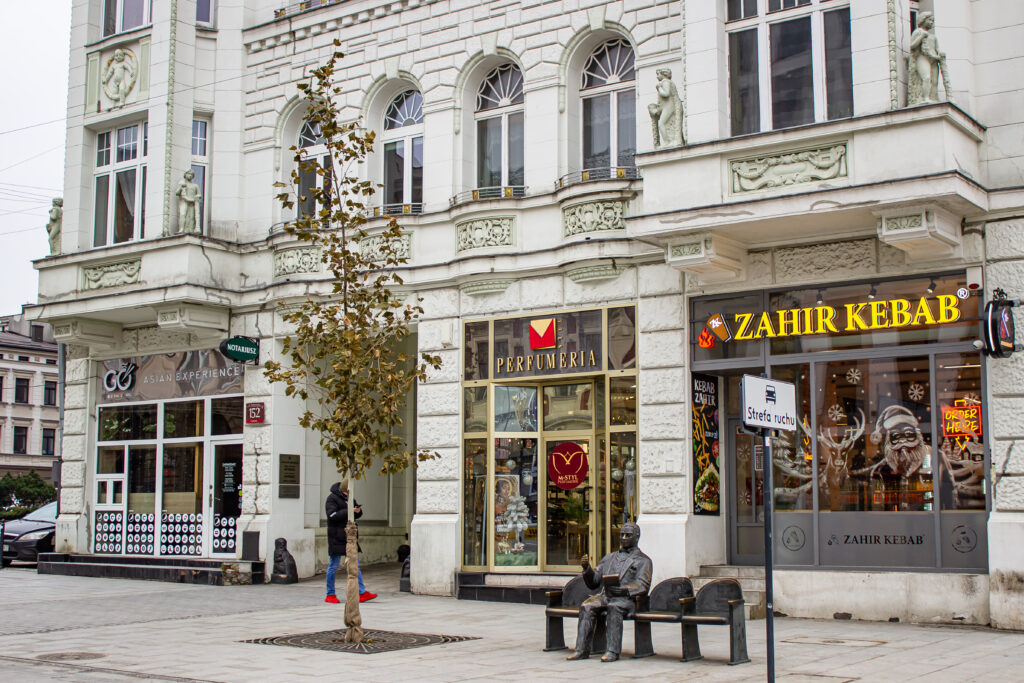Poland, a country steeped in rich history and vibrant culture, boasts an array of stunning cities that captivate visitors with their architectural marvels, picturesque landscapes, and unique charm. From the medieval cobblestone streets to the modern urban hubs, each city tells a story of resilience, creativity, and cultural heritage. The state of Poland began to exist in 966 when Duke Mieszko accepted Baptism through Czech mediation. From that moment on, the capitals of the country were at various times: Gniezno, Kraków, Warsaw, Lodz (immediately after World War II, when Warsaw was being rebuilt). This made these cities have to develop vigorously and expand their areas of activity for both residents and tourists.
Here, we embark on a journey to uncover the five most beautiful cities in Poland, inviting you to explore their enchanting beauty and timeless allure.
Kraków
Kraków, often hailed as the cultural capital of Poland, is a city brimming with historical significance and artistic flair. Its Old Town, a UNESCO World Heritage Site, is a living museum of Gothic, Renaissance, and Baroque architecture. The Wawel Royal Castle, perched atop a limestone hill, served as the residence of Polish kings for centuries and is adorned with splendid tapestries, paintings, and sculptures. Nearby, the Rynek Główny (Main Market Square) bustles with activity, surrounded by colorful townhouses, the towering St. Mary’s Basilica with its stunning altarpiece by Veit Stoss, and the iconic Cloth Hall, once a center of trade and commerce.

Beyond the Old Town, Kazimierz, the former Jewish quarter, offers a glimpse into Kraków’s multicultural heritage, with its synagogues, Jewish cemeteries, and atmospheric cafes. Additionally, Kraków is a hub of artistic and cultural activity, with numerous museums, galleries, and theaters showcasing everything from classical masterpieces to contemporary works. The annual Kraków Film Festival, the International Cultural Centre, and the historic Jagiellonian University further cement the city’s reputation as a cultural powerhouse. Did you know that the Jagiellonian University is the oldest university in Poland? It began its activity on May 12, 1364, as another great European university after Bologna and Padua. It quickly gained a reputation as one of the best universities in Europe. Today, it attracts students from all over the world who are eager to come to Poland not only to acquire knowledge but also to get to know Polish tradition, culture, and taste Polish cuisine.
If you’re planning to visit Krakow, it’s worth checking the calendar of cultural and musical events beforehand. There’s a lot happening in this area in Krakow. Concerts, poetry evenings, jazz nights, theatrical performances, and much more – you’ll find it all on the map of Krakow.
Warsaw
As the capital and largest city of Poland, Warsaw is a dynamic blend of old-world charm and modern innovation. The Old Town, meticulously reconstructed after World War II, transports visitors back in time with its cobblestone streets, quaint squares, and historic landmarks. The Royal Castle, once the seat of Polish monarchs, now houses a museum showcasing the country’s regal heritage, while the nearby Barbican and defensive walls offer glimpses into the city’s medieval past.

Contrasting with the Old Town, Warsaw’s contemporary skyline is dominated by the Palace of Culture and Science, a towering symbol of Soviet architecture, offering panoramic views of the city from its observation deck. The city’s cultural scene is equally diverse, with world-class institutions such as the Warsaw Uprising Museum, the National Museum, and the Chopin Museum celebrating Poland’s history, art, and music. Additionally, Warsaw’s bustling nightlife, vibrant street art scene, and sprawling parks provide endless opportunities for exploration and entertainment.
The proximity to the largest airport in Poland, as well as good infrastructure and logistics, make it easy to get to the city center, where many attractions await you. You can travel around the city by metro, which is also popular among tourists.
Gdańsk
Situated on the Baltic coast, Gdańsk is a maritime marvel with a rich history of trade, commerce, and cultural exchange. The city’s Old Town, with its charming Hanseatic architecture and picturesque waterfront, is a delight to explore, with highlights including the iconic Crane Gate, the towering St. Mary’s Church, and the historic Neptune’s Fountain. The Main Town Hall, adorned with intricate Gothic detailing, offers panoramic views of the city from its observation tower.
Gdańsk’s maritime heritage comes to life at the Museum of the Second World War and the European Solidarity Centre, which chronicle the city’s role in shaping Poland’s history and identity. Moreover, Gdańsk’s vibrant cultural scene is reflected in its numerous festivals, including the St. Dominic’s Fair and the Gdańsk Shakespeare Festival, as well as its thriving arts community, with galleries, theaters, and music venues showcasing local and international talent.
Adjacent to Gdańsk, the resort town of Sopot offers a tranquil escape with its sandy beaches, elegant promenade, and iconic wooden pier, making it a popular destination for relaxation and recreation.

Did you know that Sopot has the longest wooden pier in Europe? It measures 512 meters. Tourists enjoy strolling there, taking photos, and watching sunrises and sunsets. It’s a romantic spot for all couples.
From Gdańsk, it’s close to Gdynia. You can easily get there by train connecting Gdańsk, Gdynia, and Sopot. In Gdynia, you can visit the beautiful port and explore the ships and vessels, which currently house a museum. Additionally, it’s worth considering a bike trip along the coastline. Beautiful views, the sound of the sea, and delicious fish to eat along the way. What more could you want?
Wrocław
Known as the “Venice of Poland” for its numerous bridges and picturesque waterways, Wrocław is a city of architectural splendor and cultural diversity. The Market Square, one of the largest in Europe, is the heart of the city, surrounded by colorful townhouses, the Gothic Old Town Hall, and the stunning St. Elizabeth’s Church with its intricate façade.
Wrocław’s Ostrów Tumski (Cathedral Island) is a haven of tranquility, dotted with historic churches, including the breathtaking Cathedral of St. John the Baptist, which boasts a stunning collection of medieval art and artifacts. The whimsical Wrocław Fountain, located in the nearby Szczytnicki Park, delights visitors with its enchanting water displays and light shows.

The city’s cultural scene is equally vibrant, with theaters, museums, and galleries showcasing a diverse range of artistic expression. The National Museum, the Museum of Architecture, and the Museum of Contemporary Art offer insights into Wrocław’s rich heritage and creative spirit, while the annual Wrocław Good Beer Festival and the International Puppet Theatre Festival add a touch of whimsy and delight to the city’s cultural calendar.
Another attraction of Wrocław is the famous dwarves placed in various locations around the city. It’s worth obtaining a map from the tourist information office showing the locations of the dwarves in the city and planning a trip “in the footsteps of Wrocław’s dwarves.” Some are easy to find, while others are hidden in the nooks and crannies of streets and buildings. There are more than 350 dwarves in Wrocław.
Poznań
Located in western Poland, Poznań is a city steeped in history, culture, and tradition. Its Old Town, centered around the bustling Market Square, is a showcase of architectural splendor, with highlights including the historic Town Hall, the imposing Imperial Castle, and the ornate Parish Church of St. Stanislaus. The iconic mechanical goats, which butt heads daily at noon on the Town Hall tower, are a beloved symbol of the city’s folklore and charm.

Poznań’s cultural scene is enriched by its numerous theaters, museums, and galleries, including the National Museum, the Poznań Opera House, and the Musical Instrument Museum, which celebrate the city’s artistic heritage and creative spirit. Additionally, Poznań hosts a variety of festivals and events throughout the year, including the Malta Festival, the Poznań International Fair, and the St. Martin’s Day Parade, which showcase the city’s vibrant culture and traditions.
Moreover, Poznań’s culinary scene is a gastronomic delight, with traditional Polish dishes, international cuisines, and local delicacies available at its many restaurants, cafes, and food markets, ensuring that visitors can savor the flavors of the city while exploring its historic streets and vibrant neighborhoods.
In conclusion, each of these five cities—Kraków, Warsaw, Gdańsk, Wrocław, and Poznań—offers a unique blend of history, culture, and beauty, inviting visitors to immerse themselves in Poland’s rich heritage and vibrant spirit. Whether exploring medieval castles, admiring Gothic cathedrals, or savoring local cuisine, these cities promise unforgettable experiences and lasting memories for travelers from around the world.
I wouldn’t be myself if I didn’t mention another city in Poland – Łódź. It is here that our school, Let’s Speak Polish, has its headquarters. With us, you will not only discover the secrets of the Polish language but also learn about Polish history, culture, and traditions. Our instructors will teach you popular Polish idioms and sayings, sing popular Polish songs with you, and after the lesson, you can take a stroll down the main street of the city and feel the atmosphere of Łódź. The street is full of restaurants, pubs, bars, and cafes. You will also find many monuments on it, and the historic tenements will remind you of the old times of the industrialists who once had their thriving factories here.

